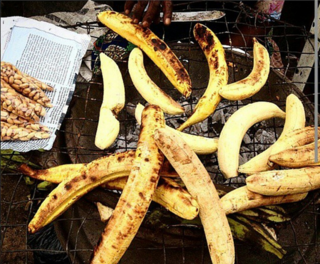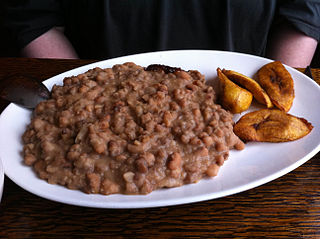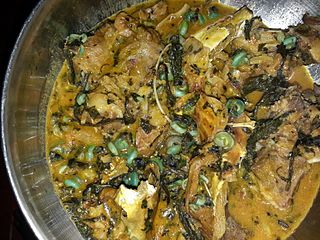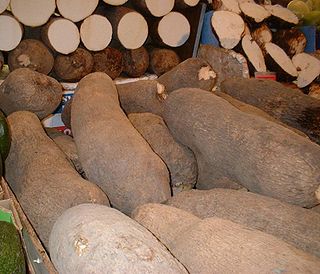 W
WÀkàrà (Hausa: kosai, Portuguese: Acarajé is a type of fritter made from cowpeas; or beans - black eye peas. It is found throughout West African, Caribbean, and Brazilian cuisines. The dish is traditionally encountered in Brazil's northeastern state of Bahia, especially in the city of Salvador. Acarajé serves as both a religious offering to the gods in the Candomblé religion and as street food. The dish was brought by enslaved peoples from West Africa, and can still be found in various forms in Nigeria, Ghana, Togo, Benin, Mali, Gambia and Sierra Leone.
 W
WÀmàlà is a local indigenous Nigerian swallow food, native to the Yoruba ethnic group in the western states of the country. It is made out of yam and/or cassava flour, or unripe plantain flour. Yams are peeled, sliced, cleaned, dried and then blended into a flour, also called èlùbọ́. Yams are white in colour but turn brown when dried. This gives àmàlà its colour. Àmàlà is from Western Africa and eaten mostly by the Yoruba people in Nigeria. Amala is mainly consumed by indigenous people of the Southwestern part of Nigeria. It could be served with a variety of ọbẹ (soups), such as ẹ̀fọ́, ilá, ewédú, ogbono or gbẹ̀gìrì.
 W
WBoli is a roasted plantain dish in Nigeria. It is native to the Yoruba people of Nigeria. It is referred to as 'boli' in South West Nigeria these people are known as the Yoruba people and is eaten with groundnuts. The Yorubas have been enjoying this delicacy for ages, it can be consumed as a snack or main meal which can be accompanied with pepper sauce filled with meat, roasted fish or fried chicken especially during the festive period. The word 'boli' is being pronounced as 'bole' due to a difference in accent in the south-south region in Nigeria. In South South Nigeria, it is referred to as 'bole' a borrowed language from the southwestern people in Nigeria and is eaten with fish during an important festival.
 W
WCooking bananas are banana cultivars in the genus Musa whose fruits are generally used in cooking. They may be eaten ripe or unripe and are generally starchy. Many cooking bananas are referred to as plantains or green bananas. In botanical usage, the term "plantain" is used only for true plantains, while other starchy cultivars used for cooking are called "cooking bananas". True plantains are cultivars belonging to the AAB Group, while cooking bananas are any cultivars belonging to AAB, AAA, ABB, or BBB groups. The currently accepted scientific name for all such cultivars in these groups is Musa × paradisiaca. Fe'i bananas from the Pacific Islands are often eaten roasted or boiled, and are thus informally referred to as "mountain plantains," but they do not belong to any of the species from which all modern banana cultivars are descended.
 W
WCorchorus is a genus of about 40–100 species of flowering plants in the family Malvaceae, native to tropical and subtropical regions throughout the world.
 W
WDodo Ikire is a traditional delicacy from Ikire in Osun State, Nigeria. It was originally made from leftover plantain but today, people prepare it from fresh ingredients which are: over-ripe plantains, pepper, oil and salt. Dodo Ikire is black and round or conical in shape.
 W
WDraw soup is a term given to certain soups originating from the southeastern and southwestern parts of Nigeria. They are made from okra, ogbono or ewedu leaves (jute). The term derives from the thick viscosity characteristic of the broth as it draws out of the bowl when eaten either with a spoon or, more characteristically, by dipping a small piece of solid (fufu) into it. It can be served with numerous Nigerian fufu meals, including eba (garri). Ewedu can be used to make a Yoruba soup that is traditionally served with amala.
 W
WẸ̀bà is a staple food mainly eaten in the West African sub-region, particularly in Nigeria and parts of Ghana. It is specifically called Eba by the Yoruba people. It is a swallow food made from dried grated cassava (manioc) flour, commonly known as garri.
 W
WEfo riro is a vegetable soup and a native soup of the Yoruba people of western Nigeria. The two vegetables most commonly used to prepare the soup are Celosia argentea and Amaranthus hybridus.
 W
WEgusi is the name for the protein-rich seeds of certain cucurbitaceous plants, which after being dried and ground are used as a major ingredient in West African cuisine.
 W
WEwa Aganyin is a street food commonly eaten across Nigeria. The beans are made to be extremely soft or mashed. It is commonly eaten with barely ground pepper and tomato sauce which is very spicy, but peppery. It has a local name of 'Ewa G'. Additional ingredients can include palm oil, onion and crayfish.
 W
WFufu is a dough-like food made from fresh or fermented cassava, found in West African as well as Caribbean cuisines. In addition to Ghana, it is also found in Sierra Leone, Guinea, Liberia, Cote D'Ivoire, Benin, Togo, Nigeria, Cameroon, the Democratic Republic of Congo, the Central African Republic, the Republic of Congo, Angola and Gabon. It is often made in the traditional Ghanaian, Cote D'ivoire, Liberia and Cuban method of separately mixing and pounding equal portions of boiled cassava with green plantain or cocoyam, or by mixing cassava/plantains or cocoyam flour with water and stirring it on a stove. The viscosity is then adjusted based on personal preference and eaten with broth-like soups. Some countries, particularly Nigeria, have a version of fufu made from fermented Cassava dough that is eaten with thick textured stews. Other flours, such as semolina, maize flour, or mashed plantains may take the place of cassava flour. Fufu is eaten with the fingers, and a small ball of it can be dipped into an accompanying soup or sauce
 W
WIn West Africa, garri refers to the creamy granular flour obtained by processing the starchy tuberous roots of freshly harvested cassava.
 W
WIrú or Eware (Edo) is a type of fermented and processed locust beans used as a condiment in cooking. It is similar to ogiri and douchi. It is very popular among the Yoruba people and Edo people of Nigeria. It is used in cooking traditional soups like egusi soup, okro soup, Ewedu soup and ogbono soup. Among the Manding-speaking people of West Africa irú is known as sumbala. The Yorubas classify iru into two types: Irú Wooro which is commonly use in making stew and Irú pẹ̀tẹ̀ which is used in making ewedu and egusi soup.
 W
WMoin-Moin or Moimoi is a Nigerian steamed bean pudding made from a mixture of washed and peeled black-eyed beans, onions and fresh ground red peppers. It is a protein-rich food that is a staple in Nigeria.
 W
WOfada rice is a name for heritage varieties of rice grown in south-west Nigeria. It is used in a variety of dishes. Ofada rices are mostly blends, and some of the rice varieties in the blends are not indigenous to Africa; however, they usually also contain African rice. It is grown almost exclusively in Ogun State, a state in Southwestern Nigeria. It is named after the town Ofada in Ogun State.
 W
WOgbono soup, is a Nigerian dish made with ground dry ogbono seeds. Ogbono seeds are originated and were first grown in Southern Nigeria. with considerable local variation. According to research by Chris Chinaka and J.C. Obiefuna, Ogbono is an indigenous forest tree associated with plants classified as 'non-timber forest products. It goes by various indigenous names in Nigeria. In the Igbo speaking region it is called 'ogbono/ugiri' depending on the variety of Igbo. In Nupe, it is called 'pekpeara', 'ogwi' in Bini, 'uyo' in Efik and 'oro' in Yoruba.
 W
WOkra or Okro soup is prepared using the edible green seed pods of the okra flowering plant as a primary ingredient. It is greenish in colour. Okra has a slippery feel when rubbed with the fingers. The edible green seed pods can also be used in stews and soups.
 W
WPalm wine, known by several local names, is an alcoholic beverage created from the sap of various species of palm tree such as the palmyra, date palms, and coconut palms. It is known by various names in different regions and is common in various parts of Africa, the Caribbean, South America, South Asia, Southeast Asia and Micronesia.
 W
WYam is the common name for some plant species in the genus Dioscorea that form edible tubers. Yams are perennial herbaceous vines cultivated for the consumption of their starchy tubers in many temperate and tropical regions, especially in West Africa, South America and the Caribbean, Asia, and Oceania. The tubers themselves, also called "yams", come in a variety of forms owing to numerous cultivars and related species.